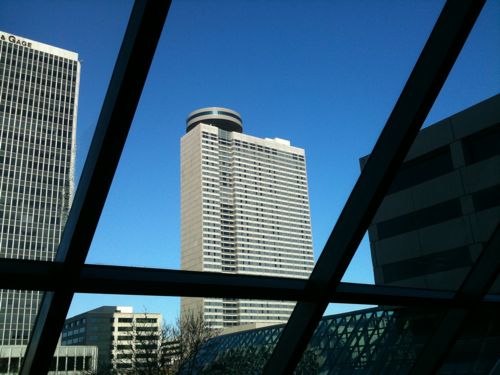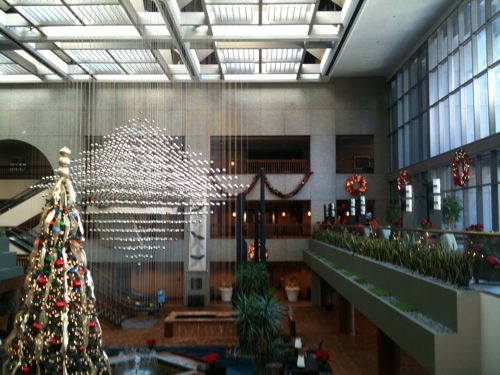Thirty Years Since the Hyatt Regency Crown Center Walkway Collapse

Tomorrow evening marks the 30th anniversary of the walkway collapse at the Hyatt Regency Crown Ceenter in Kansas City:
The Hyatt Regency hotel walkway collapse was a collapse of a walkway that occurred on July 17, 1981, in Kansas City, Missouri, United States, killing 114 people and injuring 216 others during a tea dance. At the time, it was the deadliest structural collapse in U.S. history.
On July 17, 1981, approximately 1,600 people gathered in the atrium to participate in and watch a dance competition. Dozens stood on the walkways. At 7:05 PM, the second-level walkway held approximately 40 people with more on the third and an additional 16 to 20 on the fourth level who watched the activities of crowd in the lobby below. The fourth floor bridge was suspended directly over the second floor bridge, with the third floor walkway offset several meters from the others. Construction difficulties resulted in a subtle but flawed design change that doubled the load on the connection between the fourth floor walkway support beams and the tie rods carrying the weight of both walkways. This new design was barely adequate to support the dead load weight of the structure itself, much less the added weight of the spectators. The connection failed and the fourth floor walkway collapsed onto the second floor and both walkways then fell to the lobby floor below, resulting in 111 immediate deaths and 216 injuries. Three additional victims died after being evacuated to hospitals making the total number of deaths 114 people. (Wikipedia)
A “subtle” design change resulted in the deaths of many people.

I started architecture school just four years after this accident occurred. Â This tragedy, and others, were discussed over and over, especially in structures courses. More from Wikipedia:
Investigators, including David Tonneman (a respected engineering critic), concluded that the basic problem was a lack of proper communication between Jack D. Gillum and Associates, Christopher Willoughby (a University of Michigan engineering student at the time), and Havens Steel. In particular, the drawings prepared by Jack D. Gillum and Associates were only preliminary sketches but were interpreted by Havens as finalized drawings. Jack D. Gillum and Associates failed to review the initial design thoroughly, and accepted Havens’ proposed plan without performing basic calculations that would have revealed its serious intrinsic flaws — in particular, the doubling of the load on the fourth-floor beams.
The engineers employed by Jack D. Gillum and Associates who had approved the final drawings were convicted by the Missouri Board of Architects, Professional Engineers, and Land Surveyors of gross negligence, misconduct and unprofessional conduct in the practice of engineering; they all lost their engineering licenses in the states of Missouri and Texas and their membership with ASCE. While Jack D. Gillum and Associates itself was discharged of criminal negligence, it lost its license to be an engineering firm.
This Hyatt Regency was, and is, owned by a subsidiary of Hallmark.
Hallmark was the driving force behind the Crown Center redevelopment:
Before the First World War, Downtown Kansas City was heavily populated and bustling. The area today home to Crown Center was an extension of the Union Hill historic neighborhood. Gradually, however, the center of population for the metro area moved south, and by the Second World War the area today comprising Crown Center had become dilapidated. Although Hallmark had maintained its headquarters at 26th Street and Grand Avenue since 1922, the headquarters itself and nearby Union Station comprised the only non-slum in the area. Instead, what there was were old warehouses, used car lots, and vacant buildings.
In 1966, Donald J. Hall, Sr. became President and CEO of Hallmark Cards, taking over from his father, Joyce Hall. Joyce Hall had long wished to develop the area around the corporate headquarters, and with his new leadership Donald Hall quickly made it known that he wished to renew the area entirely. Hallmark quietly began acquiring all the property surrounding its headquarters, and consulted with urban planning experts about the possibility of creating an experimental “city within a city” on the property. The City of Kansas City formally approved the plans for Crown Center (named after the Hallmark corporate symbol) by the end of 1967. (Wikipedia)
Crown Center wasn’t Urban Renewal.  Instead it was an early example of an http://en.wikipedia.org/wiki/Model_Cities_Program
To city planners, Crown Center is a mixed-use redevelopment, one of the earliest in the nation, on an 85-acre site adjacent to the international headquarters of Hallmark Cards, Inc. It has been a catalyst for change in the city’s urban core, replacing blight with quality working, living and entertainment facilities to breathe life back into the city.
Victor Gruen & Associates of Los Angeles developed the project’s original master plan, which was then modified and implemented by Edward Larrabee Barnes of New York. Crown Center was announced to the public in January 1967, and ground broke on September 16, 1968, for the first phase of the project – an underground parking facility, five-building office complex and landscaped central square. (PDF of Crown Center History)
Victor Gruen is the father of the shopping mall with the open-air Northland Center (1954), enclosed Southdale Mall (1956) and pedestrianization of a street with the Kalamazoo Mall (1959).  I’m not a fan of Gruen’s centralized designs.
I’m also not  a fan of Crown Center. I am a fan of making sure those who must be diligent to protect the safety of the public are checked and double checked.
– Steve Patterson
wow, i’ve never heard about this. interesting and sad…
Steve- hard to believe it has been thrity years. I was in architecture school at the time at K-State. When I got back to school that August I learned of several classmates who lost a family member or friend- it was very sobering. A professor from KSU was on the investigative team that did helped with the forensic engineering analysis of the failure. As students we received considerable information as the investigation progressed. Â
Other calamities have occured since, e.g. Meridian Office Plaza in Feb 1991 and I-35 Bridge Collapse in Aug 2007 continue to remind of us the human error factor.Â
wow, i’ve never heard about this. interesting and sad…
Steve- hard to believe it has been thrity years. I was in architecture school at the time at K-State. When I got back to school that August I learned of several classmates who lost a family member or friend- it was very sobering. A professor from KSU was on the investigative team that did helped with the forensic engineering analysis of the failure. As students we received considerable information as the investigation progressed.
Other calamities have occured since, e.g. Meridian Office Plaza in Feb 1991 and I-35 Bridge Collapse in Aug 2007 continue to remind of us the human error factor.
Time flies by, I don’t recall the Meridian Plaza fire: http://en.wikipedia.org/wiki/One_Meridian_Plaza
Time flies by, I don’t recall the Meridian Plaza fire: http://en.wikipedia.org/wiki/One_Meridian_Plaza
The most sobering event from my college years was the Beverly Hills Supper Club fire in Kientucky: http://en.wikipedia.org/wiki/Beverly_Hills_Supper_Club_fire That continues to make me acutely aware of the importance of both designing for safety and for reporting efforts to compromise design intent.
The most sobering event from my college years was the Beverly Hills Supper Club fire in Kentucky: http://en.wikipedia.org/wiki/Beverly_Hills_Supper_Club_fire That continues to make me acutely aware of the importance of both designing for safety and for reporting efforts to compromise design intent.
Another big fire was the MGM Grand in 1980 though most of the deaths were due to smoke inhalation: http://en.wikipedia.org/wiki/MGM_Grand_fire
Another big fire was the MGM Grand in 1980 though most of the deaths were due to smoke inhalation: http://en.wikipedia.org/wiki/MGM_Grand_fire
Crown Center is frequented by thousands of visitors each year, offers numerous family-friendly stores/plays/displays, offers an outdoor skating rink in the winter with uplifting holiday music that recalls memories of Christmas’ past….what’s not to like about Crown Center?
Crown Center is frequented by thousands of visitors each year, offers numerous family-friendly stores/plays/displays, offers an outdoor skating rink in the winter with uplifting holiday music that recalls memories of Christmas’ past….what’s not to like about Crown Center?
Crown Center is disconnected from the rest of the area, and seems to suffer from a continual sort of tourist trap vibe, with businesses struggling to stay afloat in that location. I love KC’s Union Station (attached to Crown Center by an elevated walkway) but it’s been sad to see restaurants there continually fail to attract enough business to stay open.
I’m curious to see if the aquarium being added to the space will mesh well with Science City, Hallmark, and the Crayola Cafe to build a family-friendly destination that can really stay busy.
Crown Center is disconnected from the rest of the area, and seems to suffer from a continual sort of tourist trap vibe, with businesses struggling to stay afloat in that location. I love KC’s Union Station (attached to Crown Center by an elevated walkway) but it’s been sad to see restaurants there continually fail to attract enough business to stay open.Â
I’m curious to see if the aquarium being added to the space will mesh well with Science City, Hallmark, and the Crayola Cafe to build a family-friendly destination that can really stay busy.